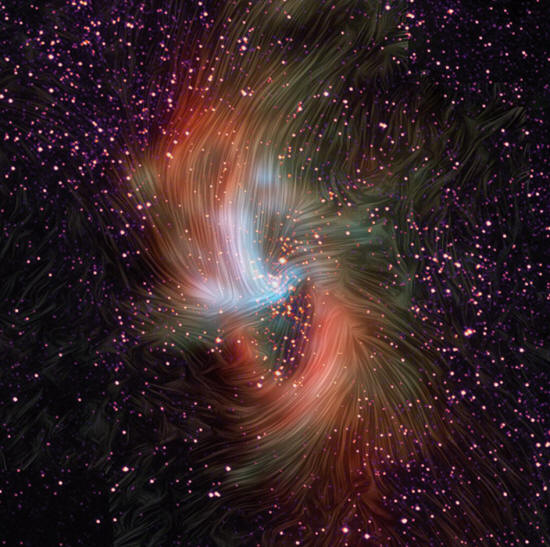|

by Nola Taylor Redd
June 14,
2019
from
Space Website

In this image, streamlines showing magnetic fields
overlay
a color image of the dusty ring surrounding
the
Milky Way's supermassive black hole.
Warm
material falling toward the black hole
creates
a Y-shaped structure, with the black hole
lying
near the intersection of the two arms.
(Image: © Dust and magnetic fields: NASA/SOFIA;
Star
field image: NASA/Hubble Space Telescope)
Magnetic
fields
may keep the
Milky Way's
supermassive
black hole quiet.
Magnetic forces may explain why the supermassive
black hole at the heart of the
Milky Way is so much quieter than its counterparts in other
galaxies.
New observations, taken by NASA's Stratospheric Observatory for
Infrared Astronomy (SOFIA)
mission, reveal unprecedented information about the strong magnetic
field lines at the center of the galaxy.
The strong gravitational pull of the Milky Way's central black hole,
which is known as
Sagittarius A*,
dominates the heart of the galaxy. In general, as material falls
into black holes, the dark giants emit high-energy radiation that
reveals their presence.
Compared to black holes
seen in other galaxies, however, the Milky Way's heart is relatively
quiet, emitting far less radiation than expected.
Understanding how black
holes interact with their magnetic fields can help scientists
understand the difference between active and quiet
black holes.
Whether they exist around
refrigerator magnets or black holes,
magnetic fields are invisible.
To study the ones
connected to Sagittarius A*, researchers relied on SOFIA, which is a
modified Boeing 747SP aircraft.
Specifically, they
employed SOFIA's newest instrument, the High-resolution Airborne
Wideband Camera-Plus (HAWC+),
to track polarized far-infrared light emitted by dust particles.
Because dust grains line up perpendicular to magnetic fields,
astronomers were able to map the shape and infer the strength of the
magnetic field around the black hole.
Combining the new map
with mid- and far-infrared images of Sagittarius A* revealed the
direction of the magnetic field.
While some of the material from the
surrounding ring of gas and dust is
falling toward the black hole, the magnetic field also directs
material away from the hungry giant, researchers said.
"The spiral shape of
the magnetic field channels the gas into an orbit around the
black hole," HAWC+ principal investigator Darren Dowell, of
NASA's Jet Propulsion Laboratory in Pasadena, California, said
in a statement.
"This could explain why our black hole is quiet while others are
active," added Dowell, lead author of a new study reporting the
SOFIA results.
Sagittarius A* is the closest
supermassive black hole to the sun and therefore provides a good
opportunity to learn how the mysterious giants function.
"This is one of the
first instances where we can really see how magnetic fields and
interstellar matter interact with each other," said study (The
Spiral Magnetic Field in the Central 5 Parsecs of the Galaxy)
co-author Joan Schmelz, an astrophysicist at NASA Ames Research
Center in California.
"HAWC+ is a
game-changer."
The results were
presented at the 234th semiannual meeting of the
American Astronomical Society, which was held this week in St.
Louis.
|


